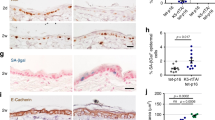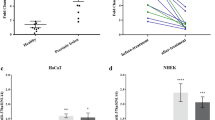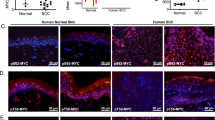Abstract
The p63α isoforms of the p53 family have been demonstrated to play a crucial role in the development and differentiation of the skin. We show that expression of the TAp63α isoform leads to an upregulation of the cutaneous papillomavirus HPV 20 promoter, which is increased at least three-fold when c-Jun is co-expressed, in contrast to a minimal increase in activity in the presence of c-Jun alone. Co-expression of TAp63α with JunB or JunD, respectively, and in combination, leads to a reduction in the viral promoter activation measured by the expression of TAp63α alone. JunB and JunD also inhibits the additive effect exerted on the TAp63α activation by c-Jun. Co-immunoprecipitation assays demonstrate a complex formation of c-Jun, JunB and JunD with TAp63α through the SAM domain mediating protein–protein interactions, which is characteristic for p63α. Co-expression of p53 mutant R248W not only downregulates the differential modulation of the viral promoter by TAp63α alone and in the presence of the Jun family members, but leads to a reduction in the protein levels of the overexpressed c-Jun, JunB, JunD, as well as TAp63α. This model system provides insight into yet unknown pathways through which TAp63α and Jun may cooperate in the pathogenesis of HPV associated cutaneous lesions.
This is a preview of subscription content, access via your institution
Access options
Subscribe to this journal
Receive 50 print issues and online access
$259.00 per year
only $5.18 per issue
Buy this article
- Purchase on Springer Link
- Instant access to full article PDF
Prices may be subject to local taxes which are calculated during checkout






Similar content being viewed by others
References
Angel P, Szabowski A . (2002). Biochem Pharmacol 64: 949–956.
Angel P, Hattori K, Smeal T, Karin M . (1988). Cell 55: 875–885.
Angel P, Szabowski A, Schorpp-Kistner M . (2001). Oncogene 20: 2413–2423.
Behrens A, Jochum W, Sibilia M, Wagner EF . (2000). Oncogene 19: 2657–2663.
Bossy-Wetzel E, Bravo R, Hanahan D . (1992). Genes Dev 6: 2340–2351.
Caldeira S, Zehbe I, Accardi R, Malanchi I, Dong W, Giarre M et al. (2003). J Virol 77: 2195–2206.
Chiu R, Angel P, Karin M . (1989). Cell 59: 979–986.
de Villiers E-M, Ruhland A, P Sekaric P . (1999). Sem Cancer Biol 9: 413–422.
Deng T, Karin M . (1993). Genes Dev 7: 479–490.
Dohn M, Zhang S, Chen X . (2001). Oncogene 20: 3193–3205.
Duijf PHG, Vanmolkot KRJ, Propping P, Friedl W, Krieger E, McKeon F et al. (2002). Hum Mol Genet 11: 799–804.
Eferl R, Wagner EF . (2003). Nat Rev Cancer 3: 859–868.
Eferl R, Ricci R, Kenner L, Zenz R, David JP, Rath M et al. (2003). Cell 112: 181–192.
Fehrmann F, Laimins LA . (2003). Oncogene 22: 5201–5207.
Fei J-W, Wei Q-X, Angel P, de Villiers E-M . (2005). Cell Cycle 4: 689–696.
Gaiddon C, Lokshin M, Ahn J, Zhang T, Prives C . (2001). Mol Cell Biol 21: 1874–1887.
Ghioni P, Bolognese F, Duijf PHG, van Bakhoven H, Mantovani R, Guerrini L . (2002). Mol Cell Biol 22: 8659–8668.
Green H, Easley K, Iuchi S . (2003). Proc Natl Acad Sci USA 100: 15625–15630.
Hess J, Angel P, Schorpp-Kistner M . (2004). J Cell Sci 117: 5965–5973.
Irwin MS, Kaelin WG . (2001). Apoptosis 6: 17–29.
Jackson S, Storey A . (2000). Oncogene 19: 592–598.
Kim CA, Bowie JU . (2003). Trends Biochem Sci 28: 625–628.
King KE, Ponnamperuma RM, Yamashita T, Tokina T, Lee LA, Young MF et al. (2003). Oncogene 22: 3635–3644.
Koster MI, Roop DR . (2004). Cell Cycle 3: 411–413.
Koster MI, Kim S, Mills AA, DeMayo FJ, Roop DR . (2004). Genes Dev 18: 126–131.
Leaner VD, Kinoshita I, Birrer MJ . (2003). Oncogene 22: 5619–5629.
Lee H, Kimelman D . (2002). Dev Cell 2: 607–616.
Longworth MS, Laimins LA . (2004). Microbiol Mol Biol Rev 68: 362–372.
Majewski S, Jablonska S . (1995). Arch Dermatol 131: 1312–1318.
McKeon F . (2004). Genes Dev 18: 465–469.
Mehic D, Bakiri L, Ghannadan M, Wagner EF, Tschachler E . (2005). J Invest Dermatol 124: 212–220.
Meixner A, Karreth F, Kenner L, Wagner EF . (2004). EMBO J 23: 1325–1335.
Melino G, Lu X, Gasco M, Crook T, Knight RA . (2003). Trends Biochem Sci 28: 663–670.
Mills AA, Zheng B, Wang XJ, Vogel H, Roop DR, Bradley A . (1999). Nature 398: 708–713.
Olivier M, Eeles R, Hollstein M, Khan MA, Harris CC, Hainaut P . (2002). Hum Mutat 19: 607–614.
Passegue E, Wagner EF . (2000). EMBO J 19: 2969–2979.
Passegue E, Jochum W, Behrens A, Ricci R, Wagner EF . (2002). Nat Genet 30: 158–166.
Pfarr CM, Mechta F, Spyrou G, Lallemand D, Carillo S, Yaniv M . (1994). Cell 76: 747–760.
Ratovitski EA, Patturajan M, Hibi K, Trink B, Yamaguchi K, Sidransky D . (2001). Proc Natl Acad Sci USA 98: 1817–1822.
Ruhland A, de Villiers E-M . (2001). Int J Cancer 91: 828–834.
Ryseck RP, Bravo R . (1991). Oncogene 6: 533–542.
Schreiber E, Matthias P, Muller MM, Schaffner W . (1989). Nucl Acids Res 17: 6419.
Schreiber M, Kolbus A, Piu F, Szabowski A, Mohle-Steinlein U, Tian J et al. (1999). Genes Dev 13: 607–619.
Shaulian E, Karin M . (2002). Nat Cell Biol 4: 131–136.
Strano S, Fontemaggi G, Costanzo A, Rizzo MG, Monti O, Baccarini A et al. (2002). J Biol Chem 277: 18817–18826.
Strano S, Munarriz E, Rossi M, Cristofanelli B, Shaul Y, Castagnoli L et al. (2000). J Biol Chem 275: 29503–29512.
Thanos CD, Bowie JU . (1999). Prot Sci 8: 1708–1710.
van Dam H, Castellazzi M . (2001). Oncogene 20: 2453–2464.
Vinciguerra M, Vivacqua A, Fasanella G, Gallo A, Cuozzo C, Morano A et al. (2004). J Biol Chem 279: 9634–9641.
Vogt PK . (2001). Oncogene 20: 2365–2377.
Vogt PK . (2002). Nat Rev Cancer 2: 465–469.
Weitzman JB, Fitte L, Matsuo K, Yaniv M . (2000). Mol Cell 6: 1109–1119.
Westfall MD, Pietenpol JA . (2004). Carcinogenesis 25: 857–864.
Wu G, Nomoto S, Hoque MO, Dracheva T, Osada M, Lee CR et al. (2003). Cancer Res 63: 2351–2357.
Yang A, Kagdad M, Wang Y, Gillett E, Fleming MD, Dötsch V et al. (1998). Mol Cell 2: 305–316.
Yang A, McKeon F . (2000). Nat Rev 1: 199–207.
Ziegler A, Jonason AS, Lefell DJ, Simon JA, Sharma HW, Kimmelman J et al. (1994). Nature (London) 372: 773–776.
Ziegler A, Leffell DJ, Kunala S, Sharma HW, Gailani M, Simon JA et al. (1993). Proc Natl Acad Sci USA 90: 4216–4220.
zur Hausen H . (1996). Biochim Biophys Acta 1288: F55–F78.
zur Hausen H . (2002). Nat Rev Cancer 2: 342–350.
Acknowledgements
We thank Bianca Berdel and Karin Gunst for excellent technical assistance. We thank Drs V DiLaurenzi and G Melino for the TAp63α construct. This study was in part supported by the Bundesministerium für Gesundheit, Berlin.
Author information
Authors and Affiliations
Corresponding author
Rights and permissions
About this article
Cite this article
Fei, JW., Angel, P., Wei, QX. et al. TAp63α indirectly regulates a cutaneous HPV promoter through complex formation with Jun family members. Oncogene 25, 3914–3923 (2006). https://doi.org/10.1038/sj.onc.1209420
Received:
Revised:
Accepted:
Published:
Issue Date:
DOI: https://doi.org/10.1038/sj.onc.1209420



